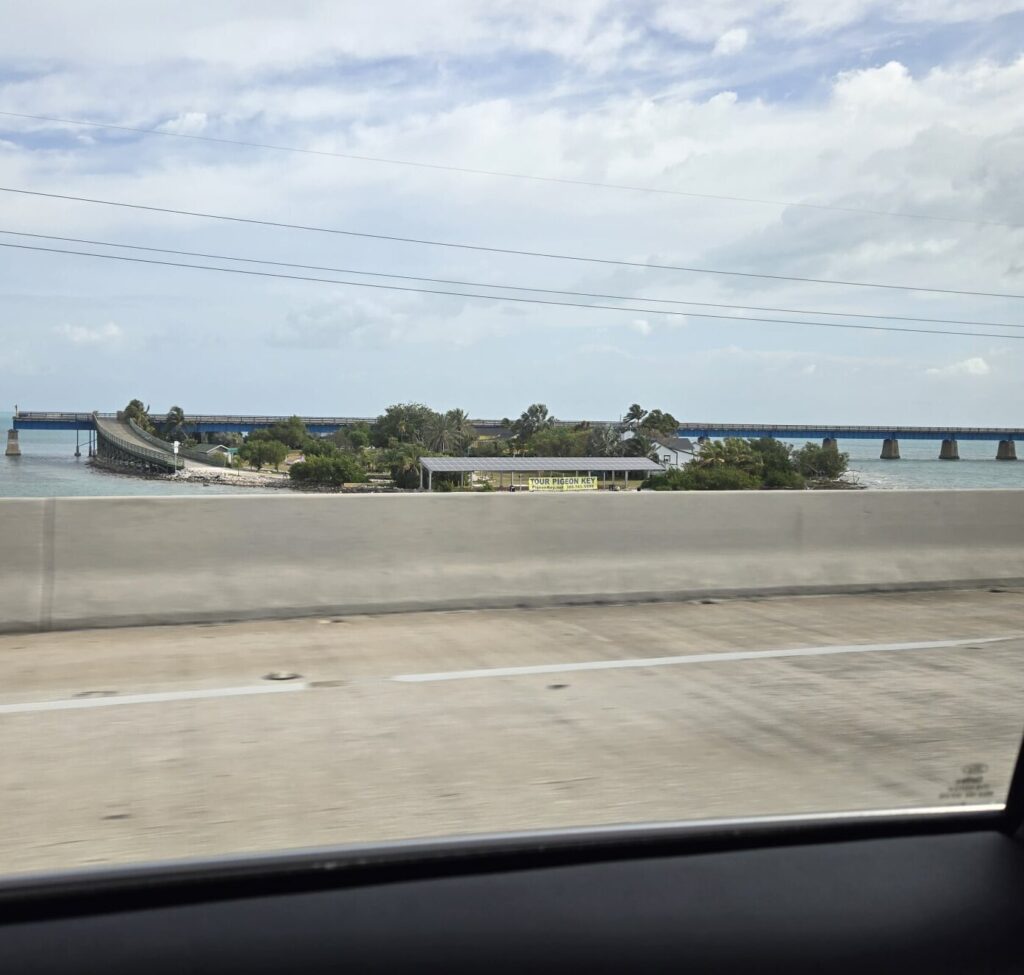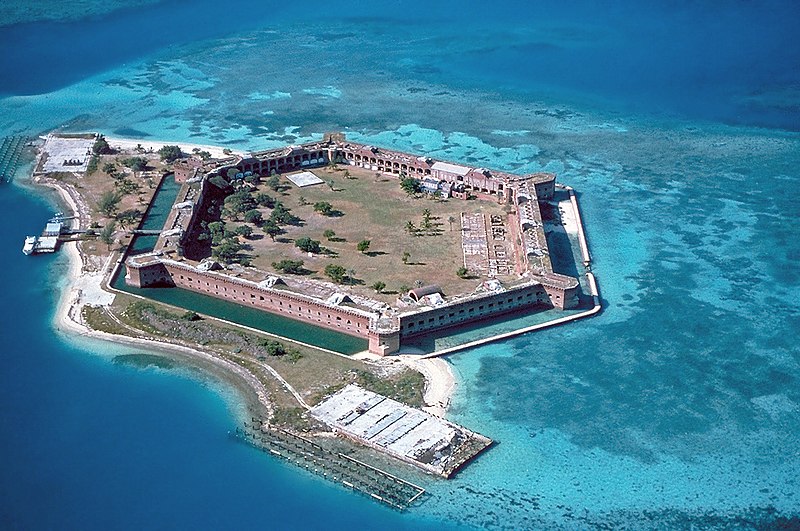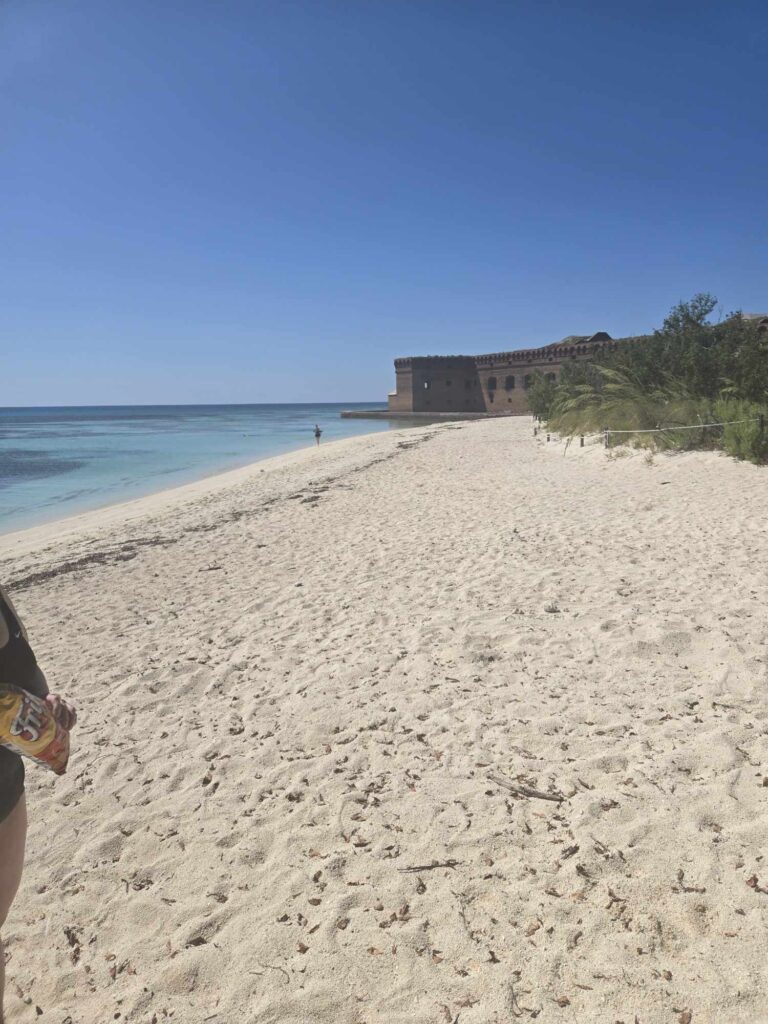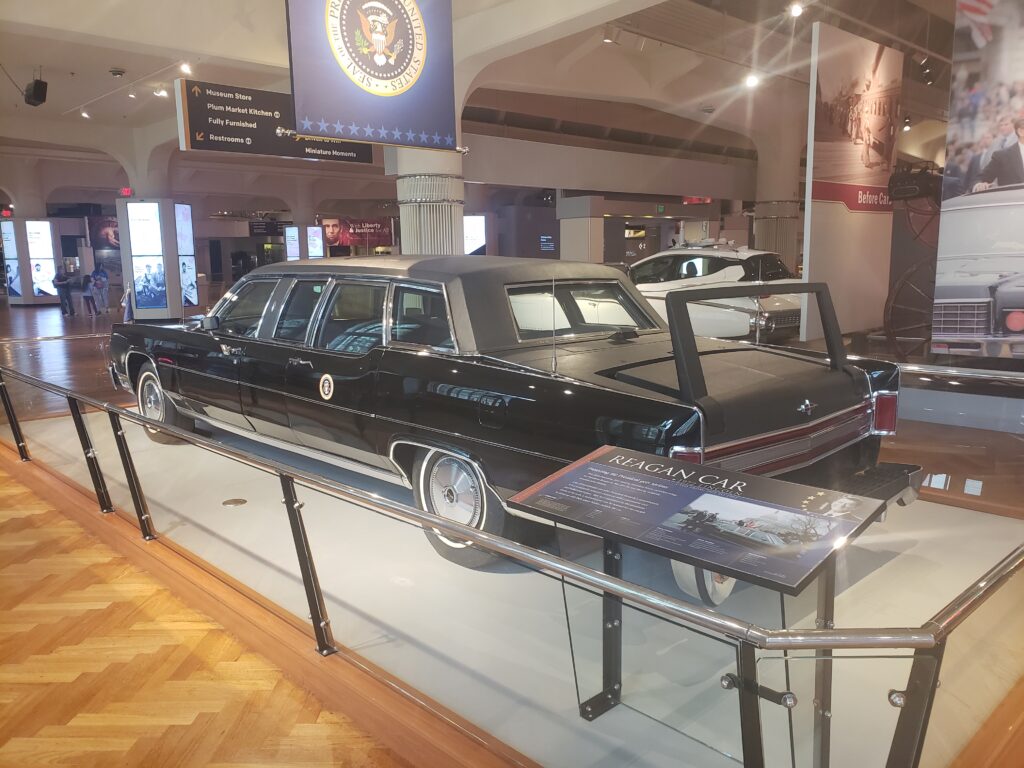Disclaimer
Please have grace while you are looking at this post. I am still struggling with formatting and putting things where I want them. I am not happy with the formatting (font size, spacing, etc.), but it is posted. I could probably spend a month and still not be happy with the formatting. However, there are videos in this post. So, there is that achievement. Like Kathy told me today, “We are still learning. We are GEEZERS!
Getting there
Kathy’s first adventure after retirement was taking a trip to Key West with her sisters, Karen and Kris, to celebrate Karen’s birthday. They flew direct from Detroit to Miami, rented a car, and made the 113-mile trip down Hwy 1 from Miami to Key West. This journey takes about 3.5 hours, depending on how many times you stop to look around. The sisters have been to Key West many times and just wanted to get to the final destination. As you can imagine, there are many things to do and see on the way to Key West. The Keys are divided into 3 separate parts: the upper, middle, and lower keys. They are all connected by Hwy 1.


Hwy 1 originally started as the Florida Keys Over-Sea Railroad and was funded by Florida millionaire Henry Flagler. It took seven years for his army of 400+ men to construct the railroad’s bridges and land-based tracks, but finally in 1912, the first train arrived in Key West. The railway operated for about about 20 years carrying freight and wealthy travelers before it was destroyed by the Labor Day Hurricane of 1935. The United States Government then purchased the railway and converted it to the Overseas Highway. In 1987, thirty-seven of the original bridges were replaced by wider, heavier spans, including the well-known Seven Mile Bridge that connects Marathon to the lower keys.
Seven Mile Bridge
Once you leave Marathon, you begin traveling on the The Seven Mile Bridge. Not only is the Seven Mile Bridge a historic landmark but was also once nicknamed “The Eighth Wonder of the World”. If you look out your car window, you can still see the Old Seven Mile Bridge. This section is 2.2-mile span closed to motor traffic in the 1980’s. This section connects Marathon and Pigeon Key, the 5-acre island that housed the workers who built the bridge. On the Old Seven, you are allowed stroll the highway, ride your bike, or take a tram. It is common to spot dolphins, sting rays, sharks, and turtles so make sure you bring your camera while you soak up the tropical South Florida sun. On one side of the bridge is the Gulf of Mexico and the other side is the Atlantic Ocean. Can you count all the different shades of turquoise, blue, and dark navy as you breath in the warm salt air and bask in the sun? Maybe bring a picnic and have some lunch at the base of the bridge on some of the picnic tables while enjoying the tropical breezes. (Side Note – there are no bathrooms available nearby, so plan accordingly!)

This is a picture of the New Seven Mile Bridge (on the left) and the Old Seven Mile Bridge (on the right). This island on the right is Pigeon Key – where the workers lived while they were building the old bridge.
This is the view of Old Seven Mile Bridge from the rental car.


The view of Pigeon Key from the car.
Meet Fred the Tree. Fred has lived on the Old Seven Mile Bridge for about 35 years. No one is exactly sure how he got there. It is suspected by ecologists that this Australian Pine was deposited by bird droppings, took root, and has been there ever since. It’s out-of-placeness has led the locals to take a liking to the tree and everything is symbolizes. While it is unclear where the name came from, residents started calling the tree Fred and the name has become as entrenched as the tree.
That’s why when US 1 was finally reopened in the aftermath of Hurricane Irma in 2017, locals were pleasantly shocked to find Fred still standing. Fred faced one of the worst natural disasters in decades and survived. Like the people that live there, Fred came out of the storm a little battered but alive and with clear plans to stay put. Fred has enjoyed a degree of fame for being the little tree that survived the hurricane. He has gone from being a local favorite to a bonafide landmark, even having books written about him. Fred even has his own FaceBook page!
Every year around the holidays some island “elves” work to decorate Fred and get him ready for the season, adorning his branches with Christmas lights, menorahs, and ornaments. In the years since Irma, this tradition has become especially important. During the holidays they celebrate the importance of giving, family and community. It is the strength of these pillars that helped to rebuild our community in the wake of Irma, which makes the decorating of Fred an even more significant annual reminder. Islamorada times: Your Guide to Living in the Keys, accessed May 27, 2024, <https://www.islamoradatimes.com/fred-tree-5/>

Did you know that several movies include scenes filmed on the Old and New Seven Mile Bridge? This famous bridge has had starring roles in Hollywood blockbusters such as the James Bond movie License to Kill, Disney’s The Haunted Mansion, 2 Fast 2 Furious, Mission Impossible III, I Am Number Four, Leverage, and possibly my most favorite Seven Mile Bridge movie, True Lies. You remember the scene -the part in the 1994 thriller where Arnold Schwartzenegger and Tom Arnold are in a helicopter trying to save Jamie Lee Curtis, who is being held hostage by Tia Carrere in a fast-moving limousine, while trying to preventing a nuclear bomb from exploding. You know, just another day in paradise. In the movie, the bridge gets destroyed by two US Marine fighter planes, but we know better.
Staying on the island
Rather than staying at a hotel, Kathy and her sisters decided to stay at a VRBO residence called Mango Margarita. This 2 bedroom 2.5 bath home is located in Old Town and is a block from Duval Street (where all the action happens). Not only were the rooms spacious, but it has a private heated pool and a nice private patio! This is a good place to rest peacefully and soak up some sun but is close enough to participate in the fun on Duval St.



The first day they had lunch at the Waterfront Brewery, a place with some good local brews and good food that was not too expensive. Karen had a flight of beer before they left for the Dry Tortugas. That night, the girls had dinner at Abbondanza Italian Restaurant for dinner and drinks. This restaurant has always been a favorite stop of theirs. The pastas are good but there is very little gluten free items at this place. The second day at Key West was a day to chill at the VRBO and enjoy the patio and pool. They went to Martin’s for Happy Hour and 1/2 off appetizers. Drinks here are very expensive, but not too pricey if you hit it at Happy Hour. The waiter was a little snarky. Kathy said he must not have appreciated “Seniors” taking advantage of happy hour! Their third (and last) day, Kathy, Kris, and Karen spent in town. They started with lunch at Conch Republic Seafood Company (where they have been before) and it was good as always. Kathy cheated on her no gluten and had her favorite conch fritters and salad. Kathy loves her some conch fritters! They spent the afternoon walking around Mallory Square and Duval Street shopping. They stopped at the Hog’s Breath and Sloppy Joe’s (a couple well known bars) for a drink. Of course, their last stop was at the Key Lime Pie Company. The even had some gluten free options! YUMMY!
Dry Tortugas
History Lesson
Before we get into the details Kathy, Karen, and Kris’s day at the Dry Tortugas, let’s talk history. Ponce De Leon discovered the keys in 1513 while searching for the Fountain of Youth. During his visit, he caught over 100 sea turtles so the keys naturally became known at the Tortugas. They are called “dry” because there is no source of fresh water on the islands. The Dry Tortugas are located on the main shipping channel between Cuba and the United States and are surrounded by the Atlantic Ocean, The Gulf of Mexico, and the Western Carribean, making them the perfect “base” to be used by pirates for attacking merchant ships.
On the island Garden Key, you will find Fort Jefferson. Fort Jefferson is a three-tiered, six-sided, 420 heavy gun fort constructed with 16 million hand-made bricks and was designed to be a massive gun platform, impervious to assault, and able to destroy any enemy ships foolhardy enough to come within range of its powerful guns. The location of the Tortugas along one the world’s busiest shipping lanes was its greatest military asset. Though passing ships could easily avoid the largest of Fort Jefferson’s guns, they could not avoid the warships that used its harbor.





Fort Jefferson served as not only a military fort, but also as a prison for war criminals and deserters during and after the Civil War. The Fort held over 2500 prisoners during it’s time. The most famous of these prisoners was Dr. Samuel Mudd who was imprisoned for his involvement in the assassination of President Abraham Lincoln. After it’s use as a prison, the fort was used as a quarantine station for the Marine-Hospital Service from 1888-1900, during which the location was also used in the Spanish-American War.



Getting to Fort Jefferson
There are only two ways to get to the Dry Tortugas – by ferry or by sea plane. The Yankee Freedom is a 110′ high-speed catamaran that carries 175 passengers and departs Key West at 8 in the morning. During the 2hr 15 minute voyage, the onboard naturalist will give you an orientation of the area and the national park’s surroundings. You will get to enjoy the scenery of the Marquesa Islands, Boca Grande, and the opportunity to possibly see turtles and dolphins while listening to pirate stories and legends. Included with the trip is breakfast, lunch, complimentary snorkeling equipment, and admission to the Dry Tortugas National Park and Fort Jefferson. There are bars and galleys on both decks that provide beverages, extra snacks, souvenirs and essentials and accept cash or card. While at the Fort, you can enjoy beach walking, snorkeling, swimming, or just relaxing in the sun. Your paid ferry ride includes a 45 minute narrated tour of the Fort, lunch, and free time to enjoy walking where pirates walked long ago. The ferry leaves the National Park at 3pm and arrives back in Key West about 5:30pm. It is recommended to make reservations early as the ferry does fill up quickly. The cost for the day on the ferry is currently at $220 for adults and $210 for seniors (62+).
Kathy and her sisters tried to make a reservation for the ferry, but the ferry was full. So, they were left with the other option…a sea plane. Kathy is not one who is enthusiastic about flying and was not really excited to partake in this adventure, but she took a deep breath (maybe some Xanax) and jumped on. The only sea plane service to the Dry Tortugas is through Seaplane Adventures. The planes offer complimentary bottled water and soft drinks but suggest you bring your own reusable drink bottles. There are no places for food or water on the island, so everything must be brought with you and EVERYTHING must go back with you. Seaplane Adventures offers both half-day and whole-day excursions. The half-day trips are just under 4 hours long, giving you about 2 & 1/2 hours of island time, and departs both in the morning and afternoon. Whole-day trips will give you about 6 & 1/2 hours of island time.
The ladies decided to go with the half-day excursion and ended up taking the afternoon trip. The cost of the half-day trip is pricey at $466 per person. In Kathy’s words, “The seaplane trip was worth-every penny, and Joe, their pilot, was awesome!” It was a perfect day for flying and each passenger gets a window seat. One of the passengers even had his walker with him and was able to get in and out of the sea plane with little help. If you are in a wheel chair or require more assistance than a walker, the ferry is the better choice of transportation. Kathy is terrified of small planes, but Joe saw to it that they were entertained and he went out of his way to make sure they got to see some wildlife like sea turtles and dolphins. Kathy thinks she even saw a hammerhead shark. (What I want to know is exactly how close they were to the water to be able to distinguish between a dolphin and a shark!??!)




Just west of Key West is an area that is about 20 miles long where the water is only 3-5 feet deep that is known as “The Flats”. There are plenty of uninhabited islands in the area, but only Ballast Key has a home. Guess what? This island is currently up for sale for a low price of only $35 million.
After The Flats and beyond the Marquesas Islands lies “The Quicksands” where the water is up to 30 feet deep and the sea bed is made up of huge sand dunes that are continuously moved by the strong tidal currents. The Quicksands is where over a half a billion dollars worth of gold and silver is said to be strewn across an 8 mile area known from many shipwrecks. This is still an active treasure site where there are regular finds of huge Spanish emeralds. It is here that the famous salver Mel Fisher found treasures of Spanish Galleons “Atocha”‘ and “Margarita”. Galleons are large multi-decked sailing ships developed by Portugal and Spain and mainly used during the 16th to 18th centuries. The “Atocha” was a treasure ship heavily laden with copper, silver, gold, tobacco, gems and indigo that sank during a hurricane in 1622. The Santa Margarita was a galleon of 600 tons, armed with twenty-five cannons and carried a massive fortune. In registered wealth, she carried 166,574 silver “pieces of eight” treasure coins, more than 550 ingots of silver weighing 10,000 pounds, 9000 ounces of gold bars, discs, and bits. There was also a fortune of “unregistered” treasure reported to have been smuggled on the ship to avoid paying a 20 percent tax to the Spanish King. The Santa Margarita also sank during the same hurricane as the “Atocha”. Anyone want to go on a treasure hunt?
The only time that Kathy did not enjoy her seaplane flight was when they took off from land in Key West and when Joe did a sharp 360 degree turn so the other side of the plane could see the dolphins. Kathy thinks she left nail marks in the “Oh, Jesus” handle! One nice tip about the afternoon trip is that the ferry (and it’s 175 guests) leaves just after you land. That means that the island is yours!!!
Once they landed, they took a leisurely stroll part way around the fort and climbed the stair where they were treated to spectacular views! Then they walked back to grab their snorkel gear (provided by Seaplane Adventures), walked along the moat, then found a shade tree on the beach where they could leave their stuff and then entered the ocean. The water was so clear! They swam across from the beach to the walls of the fort where they saw several different kinds of fish. The girls snorkeled for about an hour, dried off on the beach, stopped at the only bathrooms on the island and made their way back to the plane. If you are an adventurous person, you can camp at the very rustic campground. Remember all your supplies must be carried in with you and you have to take all your garbage back.




The worst part of the flight (roughest) was taking off from and and landing back in Key West. The excursion to Fort Jefferson in the Dry Tortuga was by far the highlight of this trip and she would certainly do it again!
Some of you know that I have made it my mission in life to come up with the 10 Best Places to Bob. Bobbing is, of course, the action of floating in the ocean floating (or bobbing) in the waves. My favorite place in the world to bob is at Pineapple Beach Resort, Antigua. Kathy said they really enjoyed snorkeling at Fort Jefferson as the water was so clear and she did get to see some fish. She did say the the “Bob Factor” was very close to a 10, but she also likes Pineapple Beach the best so far. We will continue to search for the best Bob in the world. If you have a favorite Bob Place, feel free to send us an email and let us know at geezersgonerogue@gmail.com. We would like to know what you think. Maybe we will go there to find out for ourselves!
It is always a treat for the sisters to travel to Key West. They have been there many times and always enjoy themselves. The trip to the Dry Tortugas was definitely the highlight this time. They look forward to the next time they get to go. Who knows, maybe I will get to go with them next time! Our next post will be about Kathy’s her girls trip to Cancun……Oh how I wish I were retired. 🙂
















